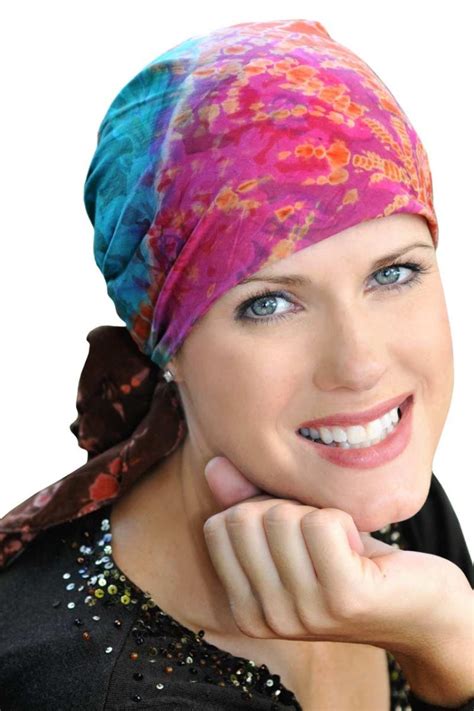Introduction

Cancer is a challenging journey that can take a toll on both physical and emotional well-being. For women, hair loss is often one of the most visible and distressing side effects of cancer treatment. Head scarves offer a comfortable and stylish way to cover hair loss while providing a sense of privacy and dignity.
Benefits of Head Scarves
Head scarves for women with cancer offer numerous benefits:
- Comfort: They protect the scalp from the elements, such as sun, wind, and cold.
- Concealment: They allow women to regain a sense of privacy and self-esteem by covering hair loss.
- Style: A wide range of head scarves are available in various colors, patterns, and materials, allowing for personal expression.
- Healing: The act of tying a head scarf can be therapeutic, providing a focus for the mind and a sense of accomplishment.
Choosing the Right Head Scarf
When selecting a head scarf, consider the following factors:
- Material: Choose a fabric that is soft, breathable, and comfortable against the skin. Silk, cotton, and bamboo are popular options.
- Size: Ensure the scarf is large enough to provide adequate coverage but not too bulky.
- Style: Select a scarf that complements your personal style and preferences. There are many different ways to tie a head scarf, so experiment with different methods.
- Accessories: Consider adding embellishments such as headbands, brooches, or hair clips to enhance the look of your head scarf.
Types of Head Scarves for Women with Cancer
Various types of head scarves are specifically designed for women with cancer:
- Pre-tied Scarves: These scarves come in various styles, such as turbans, beanies, and bandanas. They are convenient and easy to wear.
- Tube Scarves: These versatile scarves can be tied in multiple ways and provide full head coverage.
- Bandanas: Bandanas are a versatile option for covering hair loss. They can be tied in various styles and are often used for added style or to absorb sweat.
- Chemo Caps: Chemo caps are specially designed for women undergoing chemotherapy. They provide full head coverage and are often made of soft, comfortable fabrics.
Head Scarves as a Symbol of Empowerment
Head scarves have become a symbol of empowerment for women with cancer. By wearing a head scarf, women are reclaiming their identity and embracing their strength.
According to the National Cancer Institute, approximately 70% of women experience hair loss during chemotherapy. However, the American Cancer Society reports that only 12% of women wear head scarves during treatment.
Improving Patient Experience
Healthcare professionals play a crucial role in supporting women with cancer who choose to wear head scarves. By providing information and resources, healthcare professionals can help women feel more confident and comfortable with their appearance.
Strategies to Improve Patient Experience
- Offer education: Educate women about the benefits of head scarves and different options available.
- Provide resources: Provide access to resources such as head scarf support groups, online communities, and websites.
- Encourage support: Encourage family and friends to respect the woman’s decision to wear a head scarf.
- Avoid insensitive comments: Healthcare professionals and others should avoid making insensitive comments or touching the woman’s head without permission.
Conclusion
Head scarves are an essential accessory for women with cancer. They provide comfort, style, and a sense of empowerment. By selecting the right head scarf and receiving support from healthcare professionals and loved ones, women can navigate their cancer journey with confidence and dignity.
Additional Information
Table 1: Types of Head Scarves for Women with Cancer
| Type | Benefits |
|---|---|
| Pre-tied Scarves | Convenient, easy to wear, various styles |
| Tube Scarves | Versatile, full head coverage |
| Bandanas | Versatile, absorbent, added style |
| Chemo Caps | Full head coverage, designed for chemotherapy |
Table 2: Benefits of Head Scarves
| Benefit | Details |
|---|---|
| Comfort | Protection from elements, scalp sensitivity |
| Concealment | Privacy, self-esteem |
| Style | Personal expression, various options |
| Healing | Therapeutic, focus, accomplishment |
Table 3: Considerations for Choosing a Head Scarf
| Factor | Details |
|---|---|
| Material | Soft, breathable, comfortable |
| Size | Adequate coverage, not bulky |
| Style | Personal preferences, experimentation |
| Accessories | Enhance look, added style |
Table 4: Healthcare Professional Strategies
| Strategy | Details |
|---|---|
| Education | Benefits, options, resources |
| Resources | Support groups, online communities |
| Support | Respect, encouragement |
| Sensitivity | Avoid insensitive comments, touch without permission |
